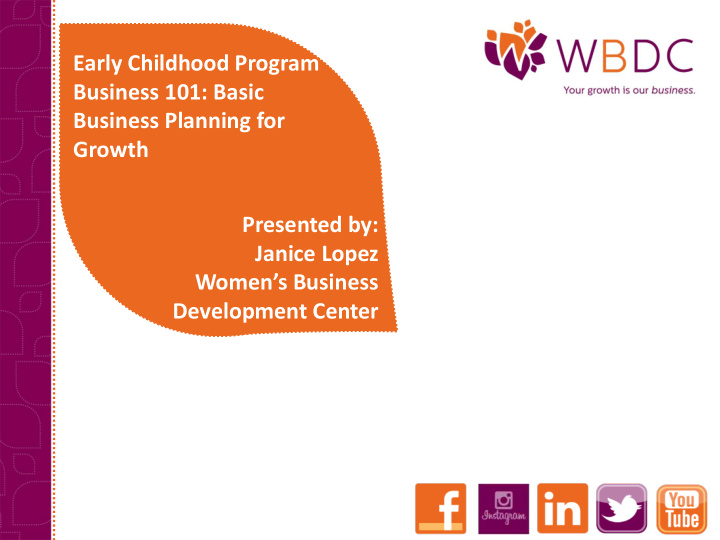



Early Childhood Program Business 101: Basic Business Planning for Growth Presented by: Janice Lopez Women’s Business Development Center
Welcome In this Webinar you will: • Obtain tools to develop a business plan • Revisit your marketing strategies and implement new ideas • Gain a better understanding of your finances and how to plan for growth
POLL QUESTIONS
Traditional Business Plan vs Business Model Canvas
Traditional Business Plan 1. Executive Summary 2. Company Summary 3. Products and Services 4. Market Analysis Summary 5. Strategy and Implementation Summary 6. Management Summary 7. Financial Plan
Business Model Canvas
Resources Business Plan • U.S. Small Business Administration www.sba.gov • Small Business Development Centers, SCORE, Women’s Business Center • State or City websites • Local Library • http://www.businessmodelgeneration.com/ downloads/business_model_canvas_poster. pdf
Marketing
Your Message
Your Message “I am a day care provider .” Is not as effective as saying: “ I am the owner of Early Childhood and Education Center, which educates children between the ages of 2 to 6.”
Assess Your Business • Who is your client? • Program • What do the parents • Employees have in common? • Environment (besides the children) • Materials • Why are their • Customer Service children enrolled in • Comunication your program? • Professional Development
Perception: Your Program • How do parents perceive your programs? • How do employees perceive your programs? • How do you perceive your programs? How do you want your programs to be perceived by all ?
Analyze the Information • How can you improve your program? • Is there opportunity to implement new programs? • How do you maintain the parents happy? Staff? • How to attract new parents? • Develop new marketing strategies
Develop a plan • Identify ways to market to your ideal client • Referrals – Family and friends – Child Care Resource and Referral Agencies • In Your Community – Who does not know your business? – Small businesses – Schools – Elected Officials
Marketing Strategies Traditional Strategies • Flyers • Brochure • Newspaper
Marketing Strategies Technology • Website • Directory Online • Social Media – Facebook – Twitter – Instagram – Yelp
Marketing Strategies • Discounts – For Referrals – By # of children enrolled • Incentives to Employees • Contests on Social Media – Facebook – Twitter – Instagram – Yelp
Tips: Marketing on Shoestring Budget • Business Cards • Signs outside home (if permited by local government) • Newletter/Blog (Constant Contact) • Social Media/Ads • Associations • Website • Signs on vehicle REFERRALS! REFERRALS! REFERRALS!
Resources • Vista Print (business cards and signs) • www.facebook.com • www.twitter.com • www.instagram.com • www.gybo.com
FINANCIALS
Why is understanding finances so important? • Gives you peace of mind • Make sound management decisions • Allows you to plan for the future • Access to capital • Save you money
Basic Financial Terms • Cash Flow Statement: – reflects money coming in and out of the business • Balance Sheet: – snapshot of a business’ financial condition (assets = liabilities + equity) • Income Statement (P & L): – measures financial performance
Basic Financial Terms & Concepts • Working Capital : measures short term financial health (current assets – current liabilities) • Debt Service Ratio : ability to repay debt (EBITDA / Total Debt Payment) • Gross Profit : profitability measurement (Sales – COGS) • Break – Even Point: minimum revenue needed to cover expenses
Financial Statements • Cashflow Statement • Profit & Loss Statement • Balance Sheet
Forecast for the year List the items that your business will need for the year. (Expected Revenues and Expenses) Examples Salaries, Rent, inventory, build-out, marketing, accounting, attorney, furniture, office, equipment, license, merchant service equipment, website, business cards, etc.
Cash Flow • Prepare a Cash Flow Projection projected out over 12 months that list: - Expenses - Revenue Assumptions - Monthly Expenses A template is available on our website at www.wbdc.org
Cashflow Statement
Income Statement • Measures financial performance • Helps you to manage you business – Where do you make money and where you do not (i.e. programs, infant care) – Where to cut back on (comparison from previous year i.e. supplies) • See trends in income – High months and low months
http://www.buildingchildcare.net/uploads/pdfs/CCCManualFINAL07.pdf
Balance Sheet – snapshot of a business’ financial condition (assets = liabilities + equity) Assets: Owns things that have value, like money in checking and savings accounts, playground equipment, computers, desks, etc.
Balance Sheet Liabilities: Owes things that other people have rights to in your business, like bills you owe your vendors, payroll taxes collected from employees but not yet paid, loans on your building or equipment, etc. The difference between the amount of things you own and what you owe is called owner’s equity , capital or net worth.
http://www.buildingchildcare.net/uploads/pdfs/CCCManualFINAL07.pdf
Next Steps… • Set goals • Identify what part of the business plan will you tackle first • You are not alone… Tap into your Resources – SBA, SCORE, Small Business Development Centers and Women’s Business Center
Thank you for your time and attention!
Contact Information Janice Lopez Director Women’s Business Center Women’s Business Development Center 8 S. Michigan Avenue, Suite 400 Chicago, Illinois 60603 Tel:(312) 853-3477 ext. 140 Fax: (312) 853-0145 E-mail: jlopez@wbdc.org
Recommend
More recommend